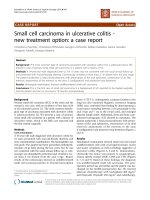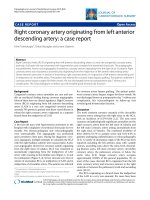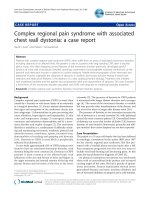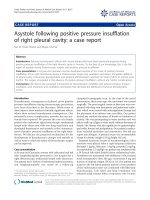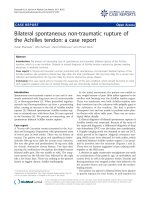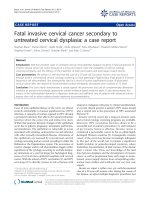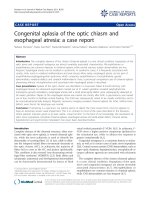Báo cáo y học: " Acute renal failure in an AIDS patient on tenofovir: a case report" doc
Bạn đang xem bản rút gọn của tài liệu. Xem và tải ngay bản đầy đủ của tài liệu tại đây (210.65 KB, 4 trang )
BioMed Central
Page 1 of 4
(page number not for citation purposes)
Journal of Medical Case Reports
Open Access
Case report
Acute renal failure in an AIDS patient on tenofovir: a case report
Pinelopi P Kapitsinou
1
and Naheed Ansari*
2
Address:
1
Department of Medicine, Jacobi Medical Center, Albert Einstein College of Medicine, Bronx, New York, USA and
2
Division of
Nephrology, Department of Medicine, Jacobi Medical Center, Albert Einstein College of Medicine, Bronx, New York, USA
Email: Pinelopi P Kapitsinou - ; Naheed Ansari* -
* Corresponding author
Abstract
Introduction: Tenofovir is a potent nucleotide analogue reverse-transcriptase inhibitor used with
other antiretroviral agents for the treatment of human immunodeficiency virus (HIV) infection.
Despite the absence of renal toxicity observed in the major clinical trials of tenofovir, several case
reports of acute renal failure (ARF) and proximal tubule dysfunction have been described.
Case presentation: We report a patient who developed ARF and Fanconi syndrome during
treatment with tenofovir. Despite severe metabolic acidosis associated with a creatinine of 9.8 mg/
dL (866 µmol/L), this patient's condition improved on discontinuation of tenofovir treatment
without requiring renal replacement therapy.
Conclusion: Vigilant screening of kidney function is required regularly after initiation of tenofovir
due to possible appearance of renal failure.
Introduction
Tenofovir is a nucleotide reverse-transcriptase inhibitor
which was approved for use by the Food and Drug Admin-
istration in 2001 for the treatment of HIV. It belongs to
the same class as adefovir and cidofovir which have well
documented renal toxicities including proximal renal
tubule cell dysfunction and acute renal failure (ARF) [1,2].
The described mechanism of tubular toxicity for the latter
two drugs is cellular accumulation through increased
entry from the hOAT (organic anion transporters located
on the basolateral side of the tubule) and decreased efflux
into tubular lumen mediated by the MRP 2 (Multidrug-
Resistance-Protein) [3]. Similar effects were not expected
with tenofovir due to decreased interaction with human
organic transporter 1 and minimal mitochondrial toxicity
in vitro [2,3].
Twenty seven cases of tenofovir related tubular dysfunc-
tion and Fanconi syndrome have been described in the
medical literature. We describe another case of a patient in
whom ARF and Fanconi syndrome developed during
treatment with tenofovir.
Case presentation
A 53-year-old woman with AIDS of 6 years duration
developed progressive weakness, dyspnea on exertion and
constipation. Her symptoms also included decreased
appetite, weight loss and episodes of lightheadness. She
had a history of drug and alcohol addiction, seizure disor-
der, stroke, pancreatitis and chronic low back pain and
she was known to have been Hepatitis B and C positive
since 2002. Antiretroviral therapy, consisting of abacavir,
lamivudine and zidovudine, had been started in March
2002, when she was found to have Pneumocystis jirovecii
pneumonia. She had not developed any other opportun-
Published: 31 March 2008
Journal of Medical Case Reports 2008, 2:94 doi:10.1186/1752-1947-2-94
Received: 11 June 2007
Accepted: 31 March 2008
This article is available from: />© 2008 Kapitsinou and Ansari; licensee BioMed Central Ltd.
This is an Open Access article distributed under the terms of the Creative Commons Attribution License ( />),
which permits unrestricted use, distribution, and reproduction in any medium, provided the original work is properly cited.
Journal of Medical Case Reports 2008, 2:94 />Page 2 of 4
(page number not for citation purposes)
istic infections. Eighteen months later, in October 2003,
her HAART regimen was switched to tenofovir (300 mg/
day), sustiva (600 mg/day) and Epivir (300 mg/day). At
that time, her creatinine was 0.8 mg/dL (71 µmol/L). A
recheck in December 2005 revealed a creatinine of 0.9
mg/dL (80 µmol/L) corresponding to eGFR 75 ml/min.
She had been on this regimen without any change in the
dose of tenofovir until she presented to hospital. Her
other medications included aspirin 81 mg/day, folic acid
and hydroxyzine. She had also been started on trimetho-
prime-sulfamethoxazole but discontinued this herself in
April 2006.
On admission, clinical examination revealed signs of mild
dehydration. Laboratory tests disclosed the following con-
centrations: sodium, 134 mEq/L; potassium, 3.4 mEql/L;
chloride, 115 mEq/L; bicarbonate, 8 mEq/L; BUN, 57 mg/
dL (20 mmol/L); creatinine, 9.8 mg/dL (866 mmol/L);
phosphorous, 5.7 mg/dL (1.8 mmol/L); CPK, 119 U/L;
uric acid, 4.9 mg/dL; lactate, 0.63 mmol/L and albumin
3.8 g/dL (38 g/L). Arterial blood gas showed academia
(pH: 7.15) with appropriate respiratory response (pCO2
21 mmHg). In a urine sample, sodium was 44 mEq/L with
a FeNa of 4%, potassium 39 mEq/L, chloride 43 mEq/L
and creatinine 82 mg/dL (7249 mmol/L). Urinalysis
showed marked glucosuria (294 mg/dL) with normoglyc-
emia and proteinuria (124 mg/dL) and an absence of
active urinary sediment. Urine pH was 6.0. The rates of
fractional excretion of phosphorus and uric acid were
58% and 37% respectively. The findings of renal ultra-
sound were normal, as were the findings for all serologic
tests. Her CD4+ lymphocyte count was 241 and her viral
load 460 HIV RNA copies/ml.
Tenofovir therapy was discontinued and her HIV regimen
was adjusted to abacavir, sustiva and epivir. Intravenous
bicarbonate therapy was initiated with simultaneous
potassium supplementation. Within the next few days,
there was slow improvement in serum creatinine and
bicarbonate levels but hypokalemia (minimum 2.5 mEq/
L) recurred, requiring discontinuation of bicarbonate.
Five days after her admission to our hospital, the patient
discharged herself against medical advice. At that time she
still had hypokalemia (2.7 mEql/L), low bicarbonate level
(16 mEq/L) and a creatinine of 6.1 mg/dl (539 mmol/L).
At follow-up at 7 months, her kidney function had
returned to normal.
Discussion
In short-term clinical trials, tenofovir did not exhibit more
frequent nephrotoxicity compared to placebo [4].
Recently, however several case reports documenting
nephrotoxicity have been described in the literature [5-8].
A number of different manifestations of kidney disease
have been reported with tenofovir, including ARF, rhab-
domyolysis, Fanconi syndrome and diabetes insipidus
[6].
Many patients diagnosed with AIDS develop acute or
chronic diarrheal syndromes with associated non-anion
gap metabolic acidosis from bicarbonate loss in the stool.
However, our patient did not report any episodes of
diarrhea and the positive urine anion gap was not consist-
ent with that possibility. Exposure to trimethoprime-sul-
famethoxazole can induce acute interstitial nephritis.
High-dose trimethoprime-sulfamethoxazole has been
associated with unexplained RTA in a series of patients.
The discontinuation of trimethoprime-sulfamethoxazole
three months prior to presentation makes both of these
scenarios in our case unlikely. Type B lactic acidosis result-
ing from mitochondrial dysfunction is well described for
nucleoside reverse transcriptase inhibitors. No hyper-
lactemia was found in this patient. Other potential causes
of severe metabolic acidosis were not identified. Our
patient had typical findings of Fanconi syndrome (hyper-
chloremic metabolic acidocis, hypokalemia, glucosuria)
but she was hyperphosphatemic. Hyperphosphatemia
was attributed to decreased GFR whereas the possibility of
pseudohyperphosphatemia secondary to multiple mye-
loma was ruled out with negative SPEP (serum protein
electrophoresis). The constellation of ARF and Fanconi
syndrome and the close temporal relationship between
discontinuation of tenofovir and improvement of renal
function suggest that tenofovir-induced nephrotoxicity
was the most likely diagnosis. The creatinine of 9.8 mg/dL
(866 mmol/L) and bicarbonate of 8 mEq/L are the highest
and lowest respectively reported in the literature among
the non-hemodialysis requiring cases of ARF secondary to
tenofovir. The first case of hemodialysis requiring ARF sec-
ondary to tenofovir was of a 40 year-old HIV man who
presented with oliguria, acidemia (pH 7.10, HCO3 6
mEql/L), lactate 7 mmol/L and creatinine of 20 mg/dL
(1768 mmol/L)[7]. However, this patient was also receiv-
ing metformin, which could be implicated particularly in
the setting of high lactate levels. The second case of hemo-
dialysis in ARF induced by tenofovir was a 65 year-old-
man with diabetes and AIDS who was admitted with cre-
atinine, 7.1 mg/dL (628 mmol/L, GFR 6.8 ml/min), blood
urea nitrogen, 68 mg/dL (24 mmol/L) and bicarbonate,
10 mEq/L [7]. This patient received two hemodialysis
treatments for azotemia. Expecting recovery of kidney
function after discontinuation of tenofovir treatment, we
did not dialyse our patient, as she was asymptomatic.
In a recent review, Zimmermann et al. analyzed the find-
ings for the 27 patients described in the literature with
tenofovir-associated ARF since December 2002 [8]. The
mean age was 45.5 years, with a ratio of men to women
3.5:1. The mean duration of tenofovir treatment was 11
months (range, 1–29 months). Our patient was taking
Journal of Medical Case Reports 2008, 2:94 />Page 3 of 4
(page number not for citation purposes)
tenofovir for 32 months, which is to our knowledge the
latest presentation of tenofovir- induced ARF.
There are no known predictors of which patients will
develop ARF associated with tenofovir. There was no cor-
relation of CD4 cell count and plasma HIV load with the
development of ARF [8]. However, low baseline GFR may
contribute to tenofovir's toxicity via increase in the serum
concentration [8].
Similarly, no predictors for occurrence of Fanconi syn-
drome exist. A recent study identified genetic variants of
hOAT1 and investigated potential effects on the func-
tional properties of this transporter. Kinetic analysis indi-
cated that the transport affinity for the nucleoside
phosphonate analogues adefovir, cidofovir and tenofovir
seemed to be decreased in the R50H-hOAT1 variant com-
pared with the wild type. This study raises the genetic var-
iation in hOAT1 as potential explanation of "different
handling" of these drugs with the associated clinical
implications [9].
Tenofovir is primarily excreted by the kidneys. Elimina-
tion is accomplished by glomerular filtration as well as by
active tubular secretion. There are several medications that
compete for renal tubular secretion, including acyclovir,
cidofovir, valcyclovir, ganciclovir and valganciclovir. Co-
administration may lead to increased serum levels of ten-
ofovir. Additionally, tenofovir causes CYP1A2 inhibition,
and drug levels may be increased when given with other
antiretroviral medication. Administration of ritonavir
alone or with lopinavir has been shown to increase the
maximum serum concentrations of tenofovir by 30%,
while didanosine and atazanavir also have been described
to have potential interactions with tenofovir [10].
Notably, our patient was not receiving tenofovir concur-
rently with any of the above listed medications.
Until recently, no long-term renal impairment was
expected as a consequence of tenofovir-related nephrotox-
icity. However the incomplete recovery of kidney function
in 5 out of 27 reported cases after a mean duration of fol-
low-up of 7.5 months raises serious concerns for occur-
rence of chronic kidney disease after discontinuation of
tenofovir [8].
A follow-up of serum creatinine, urinalysis and electro-
lytes should be performed in patients taking tenofovir.
Early diagnosis is important so that this medication can
be discontinued in a timely manner and life-threatening
electrolyte imbalances can be avoided. Hemodialysis will
not be necessary in the majority of cases, given the rapid
resolution of ARF with the discontinuation of tenofovir.
Physicians should continue to be vigilant in screening
patients well after initiation of tenofovir due to possible
late appearance of renal failure. In cases of ARF occur-
rence, persistence of kidney damage should be considered
as a possibility so that early optimization of coexistent risk
factors can be attempted.
Conclusion
We describe the case of a patient in whom ARF and Fan-
coni syndrome developed during treatment with tenofo-
vir. Vigilant screening of kidney function is required
regularly after initiation of tenofovir due to possible late
appearance of renal failure.
Competing interests
The author(s) declare that they have no competing inter-
ests.
Authors' contributions
PK has been involved in the conception, design, drafting,
and revising the manuscript. NA has been involved in the
diagnosis and treatment of the patient and revising the
manuscript.
Consent
Written informed consent was obtained from the patient
for publication of this case report and accompanying
images. A copy of the written consent is available for
review by the Editor-in-Chief of this journal.
References
1. Meier P, Dautheville-Guibal S, Ronco PM, Rossert J: Cidofovir
induced end-stage renal failure. Nephrol Dial Transplant 2002,
17:148-149.
2. Tanji N, Tanji K, Kambham N, Markowitz GS, Bell A, D'agati VD:
Adefovir nephrotoxicity: possible role for mitochondrial
DNA depletion. Hum Pathol 2001, 32:734-740.
3. Ho ES, Lin DC, Mendel DB, Cihlar T: Cytotoxicity of antiretrovi-
ral nucleotide adenofovir and cidofovir is induced by the
expression of human renal organic anion transporter 1. J Am
Soc Nephrol 2000, 11:383-393.
4. Gutmann H, Fricker G, Drewe J, Toeroek M, Miller DS: Interactions
of HIV protease inhibitor with ATP-dependent drug export
proteins. Molecul Pharmacol 1999, 56(2):383-389.
5. Coca S, Perazella MA: Acute Renal failure and tenofovir: evi-
dence of drug-induced nephrotoxicity. Am J Med Sci 2002,
324:342-344.
6. Karras A, Lafaurie M, Furco A, Bourgarit A, Droz D, Sereni D, Legen-
dre C, Martinez F, Molina JM: Tenofovir-related nephrotoxicity
in human immunodeficiency virus-infected patients: three
cases of renal failure, Fanconi syndrome and nephrogenic
diabetes insipidus. Clin Infect Dis 2003, 36:1070-1073.
7. Dupont C, Meier F, Loupy A, Page B, Rouveix E: Acute renal failure
and tenofovir: 2 new cases [abstract 694]. In Program and
abstracts of the 2nd International AIDS Society Conference on HIV Patho-
genesis and Treatment (Paris) Stockholm: International AIDS Society;
2003.
8. Zimmermann AE, Pizzoferrato T, Bedford J, Morris A, Hoffman R,
Braden G: Tenofovir-associated acute and chronic kidney dis-
ease: A case of multiple drug interactions. Clin Infect Dis 2006,
42:283-290.
9. Bleasby K, Hall LA, Perry JL, Mohrenweiser HW, Pritchard JB: Func-
tional consequences of single nucleotide polymorphisms in
the human organic anion transporter hOAT1 (SLC22A6). J
Pharmacol Exp Ther 2005, 314:923-931.
Publish with BioMed Central and every
scientist can read your work free of charge
"BioMed Central will be the most significant development for
disseminating the results of biomedical research in our lifetime."
Sir Paul Nurse, Cancer Research UK
Your research papers will be:
available free of charge to the entire biomedical community
peer reviewed and published immediately upon acceptance
cited in PubMed and archived on PubMed Central
yours — you keep the copyright
Submit your manuscript here:
/>BioMedcentral
Journal of Medical Case Reports 2008, 2:94 />Page 4 of 4
(page number not for citation purposes)
10. US Food and Drug Administration. FDA report: background
package for NDA [ />]
